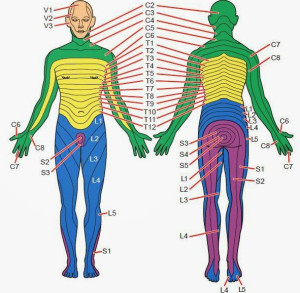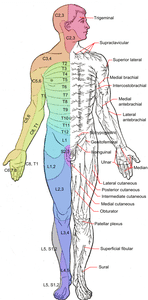Sometimes, powerful little neuroscience nuggets lurk on our bookshelves. The dermatomes map can be such a nugget.
Pain in a strip along, or around, the body can be frightening. It may be worse if the pattern is in the more scary zones such as L1 and L2, which can go to the groin and genitals, or the trunk dermatomes that wrap around the chest. But a quick dermatomal neuroscience nugget, after a thorough and appropriate assessment, can help to dethreaten the experience.
Powering up the dermatome nugget
- A dermatome can be thought of, simply, as the area of skin looked after by a nerve emerging from the back. One way to explain pain in a dermatomal pattern is “the nerve is reporting all it can to the brain, even involving the whole area it looks after – that is a great defence system you have there.”
- Care with mentioning the word “nerve”. The nerve is rarely injured – it is the surrounding tissues and fluids (the juicy neuroimmune milieu) which often change, and the nerve may be just more sensitive – not damaged. Remember also that the term “nerve root” is a metaphor and the idea of a problem “in the root of something” can be powerfully threatening
- After appropriate examination, you can usually say there is nothing wrong with the tissues and structures “underneath” the pain zone.
- People like a bit of history sometimes – Maybe tell them that one way the zones were worked out was by cutting the nerves in “volunteers” about 100 years ago and averaging out the results!
- Don’t worry if the pain is not exactly like the zones in the books – there is more than a bit of artistic licence with the strips (check out the variations in the pictures below), there is also a huge amount of overlap and when you are a bit extra sensitive the brain might become interested in neighbouring dermatomes as well.


Such a simple nugget. Maybe all readers do it? It can be a quick, but powerful, step to better pain understanding in the right circumstances. Are the dermatome maps in your office hidden on a bookshelf? Might be time to dust them off.
-David Butler

I like the comment “the nerve is rarely injured”. ………Great clinical applications here thank you David x
DB
On location 😎☀️🍗🎅🎄